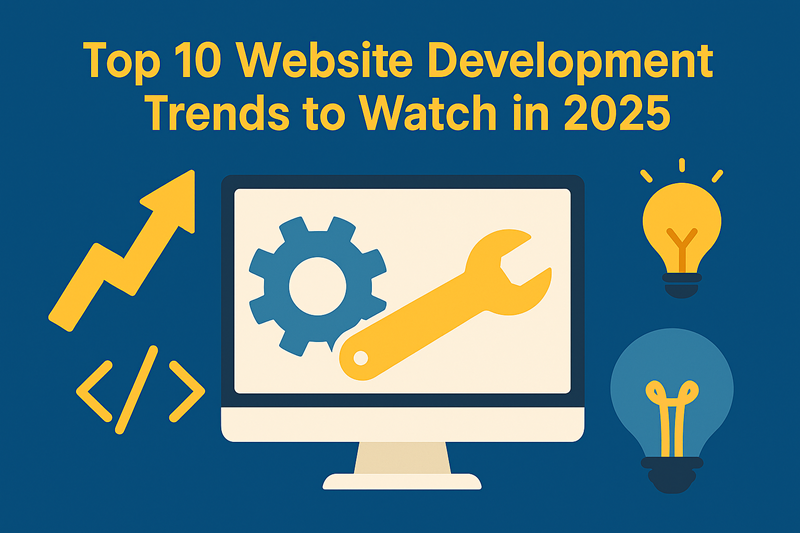In the fast-evolving digital landscape, staying ahead of the curve is essential for businesses and developers alike. As we step into 2025, the expectations from websites continue to rise – not just in terms of design but also in performance, accessibility, user experience, and backend architecture. Here are the top 10 website development trends you should watch in 2025 to ensure your website remains modern, efficient, and user-friendly.
1. AI-Powered Web Development
Artificial Intelligence is no longer a futuristic concept – it’s here, and it’s transforming web development. In 2025, AI will play a significant role in automating repetitive development tasks, providing smart coding suggestions, enhancing testing, and personalizing user experiences in real-time. AI chatbots, voice-based navigation, and recommendation engines will become more intelligent and seamlessly integrated into modern websites.
2. Progressive Web Apps (PWA)
PWAs bridge the gap between mobile apps and websites. They load fast, work offline, and provide a native app-like experience across devices. In 2025, businesses will increasingly adopt PWAs to improve engagement, reduce bounce rates, and avoid the complexities of app store deployment. Major companies like Twitter, Pinterest, and Starbucks already rely on PWAs, and the trend is set to grow further.
3. Voice Search Optimization
With the rise of voice assistants like Alexa, Siri, and Google Assistant, optimizing websites for voice search is more crucial than ever. By 2025, it’s expected that over 50% of online searches will be voice-based. Web developers will need to focus on long-tail keywords, natural language processing (NLP), and structured data to ensure content is voice-search friendly.
4. Serverless Architecture
Traditional server management can be expensive and complex. Serverless architecture allows developers to build and deploy websites and applications without managing infrastructure. Cloud providers like AWS (Lambda), Google Cloud Functions, and Azure offer scalable serverless solutions. In 2025, more websites will adopt this model to enhance scalability, security, and cost-effectiveness.
5. Headless CMS
A Headless CMS decouples the backend content management from the frontend presentation layer, giving developers complete control over how content is delivered across platforms (web, mobile, IoT, etc.). Tools like Strapi, Contentful, and Sanity are gaining traction. In 2025, this architecture will empower businesses to scale content delivery quickly and efficiently across multiple channels.
6. Enhanced Cybersecurity
As cyber threats evolve, website security will become an even higher priority in 2025. From HTTPS and multi-factor authentication to advanced firewall protection and AI-driven security monitoring, developers must embed security at every layer of development. Data privacy laws like GDPR and CCPA will also influence how personal information is handled and stored.
7. Motion UI and Microinteractions
User engagement relies heavily on experience and design. Motion UI and microinteractions make websites more dynamic, guiding users and providing visual feedback. In 2025, expect to see more CSS animations, hover effects, and transitions that don’t just look good—but also improve usability and engagement.
8. Accessibility and Inclusive Design
Designing for accessibility is no longer optional—it’s essential. In 2025, websites will be increasingly evaluated based on how accessible they are to users with disabilities. Developers will follow Web Content Accessibility Guidelines (WCAG) to ensure websites include keyboard navigation, screen reader support, alt text, color contrast, and more. Inclusive design creates better experiences for everyone.
9. Low-Code and No-Code Development
Low-code and no-code platforms like Webflow, Wix Studio, Bubble, and OutSystems empower non-technical users to build complex websites and apps. These tools reduce time-to-market and are ideal for startups and small businesses. In 2025, expect these platforms to become even more powerful with AI integration and real-time collaboration features.
10. Sustainability and Green Hosting
As environmental awareness grows, developers are becoming more conscious of the energy consumption of their websites. Sustainable web development involves optimizing performance, minimizing server usage, and using green hosting providers that rely on renewable energy. In 2025, eco-friendly development practices will not only reduce carbon footprints but also become a brand differentiator.
Final Thoughts
The world of website development is dynamic and constantly evolving. As we enter 2025, success lies in adopting technologies that enhance performance, security, accessibility, and user engagement. Whether you’re a developer, designer, or business owner, staying updated with these trends will help you build future-ready digital experiences.





